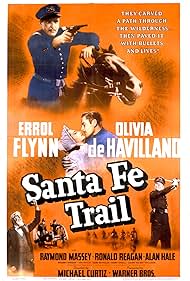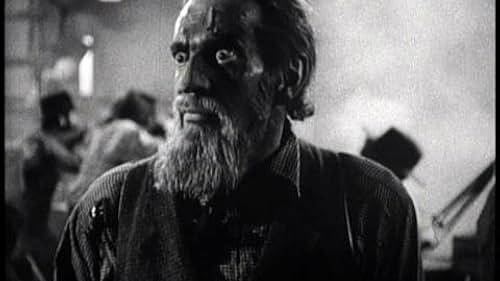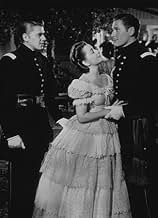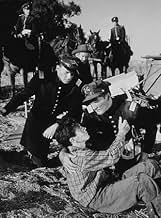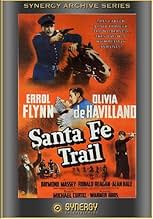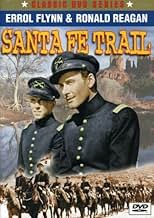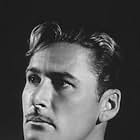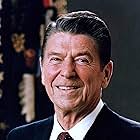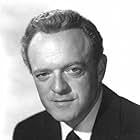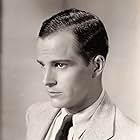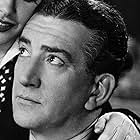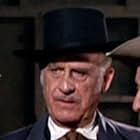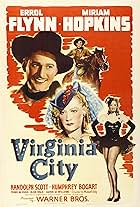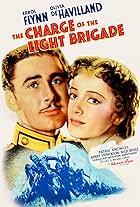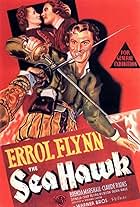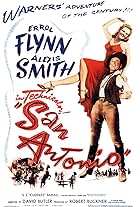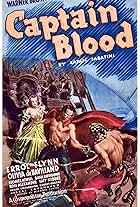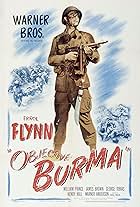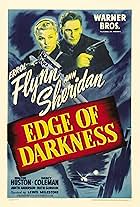In 1854, Jeb Stuart, George Custer and other graduates from West Point are posted to Kansas to help pacify the territory before railroad construction to Santa Fe can resume.In 1854, Jeb Stuart, George Custer and other graduates from West Point are posted to Kansas to help pacify the territory before railroad construction to Santa Fe can resume.In 1854, Jeb Stuart, George Custer and other graduates from West Point are posted to Kansas to help pacify the territory before railroad construction to Santa Fe can resume.
- 'Kit Carson' Holliday
- (as Olivia De Havilland)
- Director
- Writers
- All cast & crew
- Production, box office & more at IMDbPro
Storyline
Did you know
- TriviaThe seventh of nine movies made together by Warner Brothers' romantic couple Olivia de Havilland and Errol Flynn.
- GoofsThe film plays fast and loose with the facts, most noticeably, the other officers who graduate at West Point with J.E.B. Stuart in 1854: James Longstreet (1842), George Pickett (1846), Philip Sheridan (1853), John Hood (1853), and George Custer (1861).
- Quotes
Kit Carson Holliday: Jeb, I'm frightened. That boy is crippled for life. And that man on the train, he died for a principle. A man killed for a principle. One of them is wrong, but which one?
James Ewell Brown 'Jeb' Stuart: Who knows the answer to that, Kit. Everybody in America is trying to decide.
Kit Carson Holliday: Yes, by words from the East, and by guns from the West. But one day, the words will turn into guns.
- Crazy creditsOpening card: "1854, THE UNITED STATES MILITARY ACADEMY, WEST POINT When the gray cradle of the American Army was only a small garrison with few cadets, but under a brilliant Commandant, named Robert E. Lee it was already building for the defense of a newly-won nation in a new world."
- Alternate versionsThe DVD version released in Brazil by Aspen Editora Ltda. (Revista Digital Showtime Clássicos collection) runs 114 minutes.
- ConnectionsFeatured in Foreigner: I Don't Want to Live Without You (1988)
- SoundtracksThe Battle Hymn of the Republic
(uncredited)
Music by William Steffe (circa 1856)
Played during the opening credits
Variations played as background music often
Hollywood's uses (and, more often, abuses) of history fascinate me. Some films try to stick close to accounts generally accepted while others openly employ characters from real life as a launch point for stories that have little to do with actual events (hey, if Shakespeare could do it...). Many films blend fiction with fact and, usually, they serve neither well.
Director Michael Curtiz's "Santa Fe Trail" is part western, part military history, part comedic romance. Olivia de Havilland, fresh from her "Gone With the Wind" adventure, plays a frontier girl with spunk - and an ability to keep her clothes clean almost always, no matter what. She is pursued by two young army lieutenants, the soon to be legendary Confederate cavalry office, J.E.B. Stuart (Errol Flynn), and the eventually to be killed with his entire command George A. Custer (Ronald Reagan sans Bonzo). The rival suitors are typically 1940s romantics - no unfair or nasty stuff here. So sweet is the path to nuptial bliss.
The story takes place before the Civil War when the Army tried to maintain peace between pro- and anti-slavery factions in Bloody Kansas. The army officers who actually are part of history are portrayed here as being all members of the West Point Class of 1854-that would make Custer about seven years younger and earlier in graduating than was the case). No big deal.
What makes this film a remarkable document is its unflinching, for the Hollywood of the 1940s, portrayal of the evil of slavery, the pain of blacks ensnared in its web and the thundering role of John Brown, played by Raymond Massey in a powerful, gripping performance.
John Brown, the abolitionist who in life and in the film murdered slavery supporters and seized the federal arsenal at Harper's Ferry, Virginia was a zealot, not a madman (he refused an opportunity to plead insanity at the trial which ended in his death sentence). Massey, one of the greatest actors of all time, captures Brown's total devotion to ending slavery - he projects passion, not psychosis. It seems to me that Massey had a picture of John Brown that he was determined to bring to life, the inane or frivolous parts of the film being totally irrelevant to his mission.
Hollywood before World War II generally treated blacks as minor props (waiters, Pullman car attendants, cooks and maids). Here a black family is traumatized by truly sinister racists. Brown's condemnations of slavery are taken from his speeches and writings. The film's producer and director and script writers took a major detour from the concerted Tinseltown effort to not produce any story that might cut into box office take in the South (and elsewhere-the North was no hotbed of campaigns for racial equality).
Worth seeing because of its unique take on slavery, for the time, and Raymond Massey's towering performance.
8/10.
- How long is Santa Fe Trail?Powered by Alexa
Details
Box office
- Budget
- $1,000,000 (estimated)
- Runtime1 hour 50 minutes
- Color
- Aspect ratio
- 1.37 : 1
Contribute to this page

